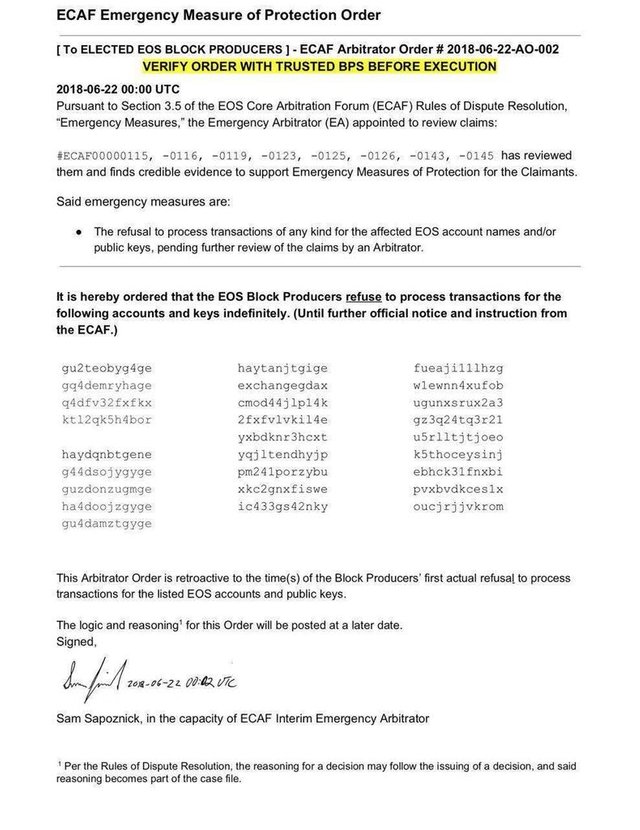RE: Why The EOS Chain Stopped & How It Was Fixed
In Bitcoin, 3 players are controlling more than 50% of the network, same for Ethereum, THAT is oligarchy!
That may well be true, but they won’t attack their baby because they created it to disintermediate the nation-states and bring in a NWO reserve currency asset named Bitcoin (aka Bitcon).
That isn’t a valid reason to create more oligarchies with proof-of-stake. Why get so excited about the same fucking shit that humans have been dealing with since antiquity? I want to get excited about real solutions. But no real solutions have been publicly presented yet.
EOS replaces Rothshild with Goldman Sachs. Nothing changes. Same ole shit for us.
An oligarchy is, by definition, self-elected with a lot of opacity.
The nation-states are run by oligarchies in so-called transparent elections but yet the oligarchy remains largely behind the curtain, because visible individuals don’t have to declare their invisible allegiances.
The voting process is permanent, every 120 seconds, the list is refreshed. A block producer miss-behaving with the community will be ejected from the top 21 very quickly by losing all his votes.
Irrelevant. Voting is an oligarchy paradigm.
And you can’t eject a liveness threshold failure and remain objectively Byzantine fault tolerant as I explained below.
Your perspective is naive and is representative of those who swallow the blue pill and are living in a fantasy. The abject failure of Steem is evidence enough that the whales either destroy a system or an oligarchy takes control to maximize rents but keep the system from collapsing in a total clusterfuck tragedy-of-the-commons.
Click off to the links in this post (and the links in the linked posts, i.e. dig and dig) if you want to read about the total failure of voting and democracy. Dig and you shall find. If you only want a soundbite, then sorry I am not going to dumb myself down to appease to a short attention span.
In the link I already provided, it is written:
An oligarchy controlled ledger is unsuitable for wide deployment on the Internet as Steem’s abject failure has exemplified for example. If DPoS isn’t controlled by oligarchy then any Byzantine witness could attack the liveness of DPOS (i.e. even with less than
⅓of the witnesses being adversarial), especially with the very small margins of network synchrony bounds required for pushing EOS to the 0.5 second per block latency. But DPoS is always controlled by an oligarchy because it employs elections. This is insoluble problem of all extant proof-of-stake systems.
The only reason you can claim ≃21 blocks for irreversibility is because DPoS has elections, but elections empower an oligarchy. So it’s disingenuous to compare a system with elections to a system such as Ouroboros or DFINITY which employ randomness to attempt to reduce some of the malevolence that an adversary could do.
And you’re entirely incorrect to insinuate that DPoS can recover easily from the chain being stuck even with perfect network synchrony if
⅓(or½if slashing is added) of the witnesses are adversarial and/or stop responding. That’s the liveness threshold of BFT. But when an oligarchy is in control, then the oligarchy can do whatever it wants, including never allowing the chain to become stuck. Without an oligarchy in control, there’s no objective way for offline nodes to know when a new DPoS election occurred and thus when the faulty witnesses were replaced. If the non-faulty witnesses vote approve the blocks recording the new election, it’s not possible to be sure those non-faulty witness will not become faulty and sign another set of blocks confirming some other election they created in secret. The offline nodes have no objectivity. That is the nothing-at-stake problem of all proof-of-stake systems and TaPoS doesn’t resolve the problem entirely.
DPoS’ approval voting is no better and arguably much worse.
Voting and democracy are oligarchy paradigms, c.f. Castellano, C., Fortunato, S., Loreto, V.: Statistical physics of social dynamics. Rev. Mod. Phys. 81(2), 591–646 (2009).
I also wrote else where:
And I wrote:
in DPoS, depending on the amount of validators, a group of whales can easily obtain total control of the validator elections, while in PoA this kind of control seems theoretically possible, but very impractical
I seem to strongly disagree with your characterization of reality. Why do you think it is impractical for an attacker to obtain
50+%of the stake? Actually AFAIK that is the norm, not the exception as I had explained in an earlier post in this thread. For example, launch an ICO then buy your ICO from yourself cost-free and surreptitiously taking 80% of the money supply. Or walk away from the development and let it crash to 50 satoshi per token, then buy it up for cheap and then restart development. Or buy it cheap in the next crypto-winter when alts are dead again. Or simply buy the50+%on the open market and after obtaining it, recoup all the costs by increasing transaction fees to the maximum that the ecosystem can bear. And take all the block rewards and all the transaction fees for every block forever at no additional cost. I have an unanswered question in prior post for @shunsaitakahashi about how he plans to solve the problem of transaction spam and allowing the market to set the transaction fees without enabling the oligarchy to raise transaction fees to nosebleed levels? That is the fundamental insoluble problem for Bitcoin and the block size issue.This is a fundamental reason why all proof-of-stake systems are run by a
50+%oligarchy behind the curtain. Seriously AFAIK this is the reality. Do you know something about this specific issue that I don’t? (intended sincerely as a question not condescending rhetorical)

Lol, you are definitively an EOS-ignorant person! Some more knowledges about the project and some more humility would suits you very well.
You think?